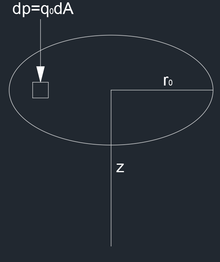Stress distribution in soil is a function of the type of soil, the relative rigidity of the soil and the footing, and the depth of foundation at level of contact between footing and soil [1].The estimation of vertical stresses at any point in a soil mass due to external loading is essential to the prediction of settlements of buildings, bridges and pressure. [2]
Some cases
Finitely loaded area
If soil is considered homogeneous and isotropic and the surface loading area is finite (a point, circle, strip), the vertical stress in the subsoil decreases as depth and radial distance from the surface loading area increases.
|
| This section needs expansion. You can help by
adding to it. (April 2022) |
Vertical line load at the surface
|
| This section needs expansion. You can help by
adding to it. (April 2022) |
Vertical Point Load at the Surface

The solution to the problem of calculating the stresses in an elastic half space subjected to a vertical point load at the surface will be of value in estimating the stresses induced in a deposit of soil whose depth is large compared to the dimensions of that part of the surface that is loaded. , [3]
Below centre of uniformly loaded circular area

References
- ^ Luévanos Rojas, Arnulfo (2014). "Design of boundary combined footings of rectangular shape using a new model". Dyna. 81 (188): 199–208. doi: 10.15446/dyna.v81n188.41800.
- ^ Stress distribution in soil
- ^ page 5
- ^ Below centre of uniformly loaded circular area page 10






![{\displaystyle \Delta \sigma _{z}=-{\frac {3Pz^{3}}{2\pi R^{5}}}=-{\frac {3P}{2\pi }}{\frac {z^{3}}{(r^{2}+z^{2})^{5/2}}}=-{\frac {3P}{2\pi z^{2}\left[1+\left({\frac {r}{z}}\right)^{2}\right]^{\frac {5}{2}}}}}](https://wikimedia.org/api/rest_v1/media/math/render/svg/2268e3c79bc0eabad6c2f3228b9a7290018046b2)
![{\displaystyle \sigma =q\{1-{\frac {1}{[({\frac {R}{z}})^{2}+1]^{3/2}}}\}}](https://wikimedia.org/api/rest_v1/media/math/render/svg/e208589db46e6eb971b6d418162ac4fdf0c82bac)